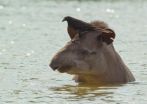(Press-News.org) NEW YORK (January 22, 2012) —Wildlife Conservation Society scientists have documented a thriving population of lowland tapirs – the strange forest and grassland-dwelling herbivore with the trunk-like snout – living in a network of remote national parks spanning the Peru-Bolivia border.
Using a combination of camera traps, along with interviews with park guards and subsistence hunters, WCS estimates at least 14,500 lowland tapirs in the region. The population bridges five connected national parks in northwest Bolivia and southeastern Peru.
The WCS findings were described in the December issue of the journal Integrative Zoology. Authors include Robert Wallace, Guido Ayala, and Maria Viscara of WCS's Greater Madidi-Tambopata Landscape Program.
The study synthesizes 12 years of research on lowland tapirs in the region. Together with WCS studies on jaguars, the results underscore the importance of this protected area complex for the conservation of Latin America's most charismatic terrestrial wildlife species.
"The Madidi-Tambopata landscape is estimated to hold a population of at least 14,500 lowland tapirs making it one of the most important strongholds for lowland tapir conservation in the continent," said the study's lead author Robert Wallace. "These results underline the fundamental importance of protected areas for the conservation of larger species of wildlife threatened by hunting and habitat loss."
The lowland tapir is the largest terrestrial mammal in South America, weighing up to 300 kg (661 pounds). Its unusual prehensile proboscis or snout is used to reach leaves and fruit. Tapirs are found throughout tropical forests and grasslands in South America. However, they are threatened by habitat loss and especially unsustainable hunting due to their large size, low reproductive rate (1 birth every 2-3 years), and ease of detection at mineral licks in the rainforest. Lowland tapirs are considered Vulnerable by the IUCN.
WCS collected and systematized 1,255 lowland tapir distribution records in the region. These records came from research observations and camera trap photographs as well as interviews with park guards of Madidi, Pilón Lajas and Apolobamba National Parks in Bolivia, and Bahuaja Sonene and Tambopata National Parks in neighboring Peru, and subsistence hunters from 19 Takana and Tsimane' communities.
Camera trap data revealed that lowland tapir abundance was higher at sites under protection than sites outside protected areas. At one site sampled over time, the Tuichi River, camera trapping has revealed that lowland tapir populations have been recovering following the creation of Madidi National Park in 1995. Prior to the creation of the park, loggers had hunted heavily in this area.
Madidi National Park contains 11 percent of the world's birds, more than 200 species of mammals, 300 types of fish, and 12,000 plant varieties. The 19,000 square-kilometer (7,335 square mile) park is known for its array of altitudinal gradients and habitats from lowland tropical forests of the Amazon to snow-capped peaks of the High Andes.
Working with government partners in Bolivia and Peru, the Greater Madidi-Tambopata Landscape Conservation Program aims to develop local capacity to conserve the landscape and mitigate a variety of threats to biodiversity and wildlife including lowland tapirs, including road construction, logging, unsustainable natural resource use, and agricultural expansion.
Julie Kunen, WCS Director of Latin America and Caribbean Programs said: "WCS commends our government and indigenous partners for their commitment to the Madidi-Tambopata Landscape. Their dedication is clearly paying off with well-managed protected areas and more wildlife."
INFORMATION:
WCS's conservation research in the Madidi-Tambopata Landscape has been made possible by the Gordon and Betty Moore Foundation, The John D. and Catherine T. MacArthur Foundation, the blue moon fund, USAID, the Beneficia Foundation, the Disney Worldwide Conservation Fund, Woodland Park Zoo, and other generous supporters.
The Wildlife Conservation Society saves wildlife and wild places worldwide. We do so through science, global conservation, education and the management of the world's largest system of urban wildlife parks, led by the flagship Bronx Zoo. Together these activities change attitudes towards nature and help people imagine wildlife and humans living in harmony. WCS is committed to this mission because it is essential to the integrity of life on Earth. Visit www.wcs.org.
The Gordon and Betty Moore Foundation, established in 2000, seeks to advance environmental conservation, patient care and scientific research. The goal of the Foundation's Andes-Amazon Initiative is to maintain the climatic function and biodiversity of the Amazon Basin by promoting forest conservation and addressing the drivers of deforestation and forest degradation. For more information, please visit www.moore.org.
The MacArthur Foundation supports creative people and effective institutions committed to building a more just, verdant, and peaceful world. In addition to selecting the MacArthur Fellows, the Foundation works to defend human rights, advance global conservation and security, make cities better places, and understand how technology is affecting children and society. More information is at www.macfound.org.
Paradise found for Latin America's largest land mammal
2013-01-22
ELSE PRESS RELEASES FROM THIS DATE:
Immune system molecule with hidden talents
2013-01-22
This press release is available in German.
Dendritic cells, or DCs for short, perform a vital role for the immune system: They engulf pathogens, break them down into their component parts, and then display the pieces on their surface. This in turn signals other immune cells capable of recognizing these pieces to help kick-start their own default program for fighting off the invaders. In order to do their job, the DCs are dependent upon the support from a class of immune system molecules, which have never before been associated with dendritic cells: antibodies, best ...
New research on military traumatic brain injury
2013-01-22
Philadelphia, Pa. (January 22, 2013) – Researchers are making new strides in understanding the health consequences and treatment and rehabilitation needs of combat veterans and other service members affected by traumatic brain injury (TBI). The January-February issue of The Journal of Head Trauma Rehabilitation, official journal of the Brain Injury Association of America, is a special issue devoted to new research in military TBI. The journal is published by Lippincott Williams & Wilkins, a part of Wolters Kluwer Health.
"For the second consecutive year, we've expedited ...
New information on binding gold particles over metal oxide surfaces
2013-01-22
The strong binding of gold on electronically modified calcium oxide can now be understood in detail. In a computational study, researchers Jenni Andersin, Janne Nevalaita, Karoliina Honkala and Hannu Häkkinen at the University of Jyväskylä Nanoscience Center have shown how redox chemistry entirely determines the adsorption strength of gold on the modified oxide where one metal atom is replaced with molybdenum. The study was funded by the Academy of Finland.
The research team applied the so-called Born-Haber cycle to analyse how different terms contribute to adsorption ...
The Nurse Practitioner marks 25th Annual Legislative Update
2013-01-22
Philadelphia, Pa. (January 22, 2013) – The most comprehensive review of new legal and regulatory issues affecting advanced nursing practice across the United States is now available in the "25th Annual Legislative Update," presented exclusively by The Nurse Practitioner: The American Journal of Primary Healthcare. The Nurse Practitioner is published by Lippincott Williams & Wilkins, a part of Wolters Kluwer Health.
Compiled by Susanne J. Phillips, MSN, FNP-BC, the annual supplement presents a comprehensive review of the legislative proceedings, bills, and laws pertaining ...
South Americans want policy makers to put ethics above price
2013-01-22
Researchers at Royal Holloway university have found that Brazilians and Chileans want the state to buy on social and environmental criteria, not just on price.
Based on this pioneering research, researchers from Royal Holloway have been invited to be the first academics to join the UN Environmental Programme's global Sustainable Public Procurement Initiative and attend its meeting in Paris this week.
The Choices Project is a collaboration between Royal Holloway, the Universidade Federal do Rio de Janeiro and Universidad Diego Portales. The project team also involves ...
Mayo Clinic expert suggests proper techniques for newborn bathing and skin care basics
2013-01-22
ROCHESTER, Minn. -- Bathing a tiny newborn can be an exciting experience for parents, but it can also be intimidating. Newborns are small and vulnerable, slippery when wet, and the products marketed for their delicate skin can leave parents with abundant choices. As newborns are welcomed into the world, their skin needs to adapt to the new environmental changes around them. It's important for parents to understand proper bathing techniques and the appropriate skin care needed for their little one.
Pediatric dermatologist Dawn Davis, M.D., of Mayo Clinic Children's Center ...
Study: Odd biochemistry yields lethal bacterial protein
2013-01-22
CHAMPAIGN, Ill. — While working out the structure of a cell-killing protein produced by some strains of the bacterium Enterococcus faecalis, researchers stumbled on a bit of unusual biochemistry. They found that a single enzyme helps form distinctly different, three-dimensional ring structures in the protein, one of which had never been observed before.
The new findings, reported in Nature Chemical Biology, should help scientists find new ways to target the enterococcal cytolysin protein, a "virulence factor that is associated with acute infection in humans," said University ...
Scientists find gene interactions that make cocaine abuse death 8 times more likely
2013-01-22
COLUMBUS, Ohio – Scientists have identified genetic circumstances under which common mutations on two genes interact in the presence of cocaine to produce a nearly eight-fold increased risk of death as a result of abusing the drug.
An estimated one in three whites who died of cocaine exposure is a carrier of variants that make cocaine abuse particularly deadly.
The variants are found in two genes that affect how dopamine modulates brain activity. Dopamine is a chemical messenger vital to the regular function of the central nervous system, and cocaine is known to block ...
Tiny fossils hold answers to big questions on climate change
2013-01-22
The western Antarctic Peninsula is one of the fastest warming regions on the planet, and the fastest warming part of the Southern Hemisphere.
Scientists have debated the causes of this warming, particularly in light of recent instrumental records of both atmospheric and oceanic warming from the region. As the atmosphere and ocean warm, so the ice sheet (holding an equivalent of 5 metres of global sea level rise, locked up in ice) becomes vulnerable to collapse.
Now research led by Cardiff University published in Nature Geoscience has used a unique 12,000 year long ...
New study examines on/off relationships and 'sex with an ex' among teenagers and young adults
2013-01-22
Los Angeles, CA (January 22, 2013)- A new study finds that nearly half of older teenagers and young adults break up and get back together with previous dating partners and over half of this group have sex as part of the reconciliation process. This study was recently published in the Journal of Adolescent Research, a SAGE journal.
Researchers Sarah Halpern-Meekin, Wendy Manning, Peggy Giordano and Monica Longmore studied data on 792 daters and cohabiters ages 17 to 24, also known as "emerging adults." The researchers studied two relationship patterns specifically – reconciliation ...



